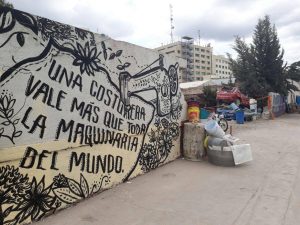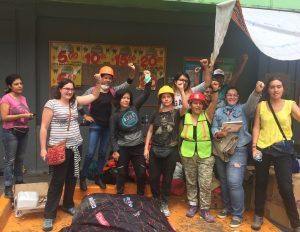 In a few seconds, the four-story building at Bolivar 168 collapsed in a cloud of dust. The home videos on YouTube record spectators’shock and the hysteria of mothers of the students of the nearby Simon Bolivar School. The school children survived. Most of the workers in the fallen building did not.
In a few seconds, the four-story building at Bolivar 168 collapsed in a cloud of dust. The home videos on YouTube record spectators’shock and the hysteria of mothers of the students of the nearby Simon Bolivar School. The school children survived. Most of the workers in the fallen building did not.
The dust quickly settled, revealing a pile of debris swept up by soldiers and Mexico City employees in record time. But questions about what really happened there– before and after the quake– have still not dissipated. Bolivar 168 has become a symbol of the enormous distance between the urban geography we see every day and the urban geography that is hidden, which in turn hides the corruption, exploitation, and insensitivity experienced behind its flimsy walls.
This geography is populated by human beings that don’t exist in official registries and are nameless to most of society. In a patriarchal society like ours, that means the majority of them are women. It was soon learned that several businesses existed in the hapless building located where Bolivar St. crosses Chimalpopoca–among them a clothing store and a garment shop. For people who remembered the earthquake of 1985, or read about it later, it seemed that history was repeating itself.
 In 1985, buildings near this one fell in the city’s most powerful and destructive earthquake. On that September 19-the very same day 32 years ago– hundreds of seamstresses who labored in sweatshops under conditions that bordered on slavery were entombed in the rubble. Survivors told how the bosses came to remove their documents, assets, and machinery, leaving the women workers—alive and dead—in the ruins. Mexican society reacted with outrage. Several seamstresses related that the bosses locked the doors when the earthquake began, not permitting anyone to exit. The garment workers who survived began to seek each other out, to organize and to demand their rights, among them the right to have their own labor union.
In 1985, buildings near this one fell in the city’s most powerful and destructive earthquake. On that September 19-the very same day 32 years ago– hundreds of seamstresses who labored in sweatshops under conditions that bordered on slavery were entombed in the rubble. Survivors told how the bosses came to remove their documents, assets, and machinery, leaving the women workers—alive and dead—in the ruins. Mexican society reacted with outrage. Several seamstresses related that the bosses locked the doors when the earthquake began, not permitting anyone to exit. The garment workers who survived began to seek each other out, to organize and to demand their rights, among them the right to have their own labor union.
The impact of the contrasts—tragedy and resistance, abandonment and solidarity, death and the fight for justice—along with the tireless work of the seamstresses, led to official recognition of the first independent union–of and for women, with women in leadership–in the contemporary history of the country. This uniquely feminist project encompassed all of aspects of a working woman’s life–not just her work, but also empowerment in the omestic sphere, education and culture.
The “Sept. 19th Seamstresses Union” became a source of inspiration on a global scale. Support and solidarity poured in from all corners of the world to the “union born in the ruins.” In exceedingly adverse conditions, the small union managed to change the lives of thousands of woman garment workers and to awaken the conscience of a nation.
With this lesson on the collective power of women, when the building collapsed at Bolivar and Chimalpopoca, feminist brigades arrived to organize rescue efforts and demand a search for workers. They confronted a lack of information on the most basic and necessary questions: there were no lists of who worked in the b uilding, no official registry of the businesses and their owners. The conditions workers labored under were not known, nor the condition of the building that collapsed. The mystery deepened with the enormous deployment of security forces in the area, contradictory official information, and rampant rumors.
uilding, no official registry of the businesses and their owners. The conditions workers labored under were not known, nor the condition of the building that collapsed. The mystery deepened with the enormous deployment of security forces in the area, contradictory official information, and rampant rumors.
In the end, rescue workers pulled out 21 bodies out of the ruins, mostly women. They rescued an unconfirmed number of survivors–somewhere between two and five. Several workers remain missing. Taiwanese, Koreans, and Mexicans figure on the incomplete lists of the dead and missing, confirming the useof immigrant labor.
Despite the confusion in the information and the silence of the city government, there are many parallels between the seamstresses of 1985 and 2017. The most obvious is that they worked in places that did not comply with minimum safety standards. The building on Bolivar was seriously damaged in the earthquake of 1985, and the government knew it. Nonetheless, not only did officials allow companies to operate there, but they also allowed them to install two heavy telephone antennas on the roof, overloading a building that was already weakened.
Mexican reporters interviewed neighbors who stated that in Bolivar too the owners restricted entry and exit. And just as in 1985, private teams arrived to remove files, machinery, and assets before ascertaining whether there were any survivors trapped. “The life of a single seamstress is worth more than all the machinery in the world,” was written on a wall still standing by the wreckage. Private teams gathered documents from the remains of the building and stored them at the Simón Bolívar School. They were all then removed, despite that they could reveal important facts on possible corruption and other irregularities that led to the tragedy.
For Marisol Hernandez, Conchita Guerrero, and Aldegunda Rojas, this repeated history comes as no surprise. Co-founders and former members of the Executive Committee of the September 19th Union, they state that conditions for seamstresses have not improved in more than three decades. Exploitation continues, and in many ways is worse as production has globalized and much production is done as piecework in homes. The discrimination and lack of regard for their lives they faced back then continues. Women garment workers continue to be victims of the corruption that rules in the city’s hidden world.
The structural flaws were never corrected between then and now—not only in walls and roofs, but in the labor structure that dictates that poor women sacrifice their lives working in the worst conditions, with the highest risks.
For these union leaders, there is another important parallel. In 2017, solidarity flourished at the site of the fallen sweatshops at Bolivar, and throughout the city, just as it did in the Mexico City of 1985. In a group interview, Hernandez, Guerrero and Rojas commented on the critical role of thousands of young people–men and women–who came out to rescue and offer help of all kinds. Organized feminist groups played a central role in giving voice to women garment workers and to keeping alive the hope of life and justice. In Bolivar, they refused to allow authorities to bring in heavy machinery for clean up until workers were accounted for, and the search for survivors ended. Then afterward, they paid homage to the lives lost.
The task now is to keep digging in the ruins to find, if no longer life, then at least truth. Who were these women workers? What did they do and what did these companies do, among them Dash Cam, which according to reports produced clandestine cameras to monitor truck drivers? Who permitted the building to operate in dangerous conditions? Why the rush to carry off the last piece of evidence? Why surround the site with hundreds of soldiers and police? Eight human rights organizations have requested information from the authorities and others have filed a petition demanding the list of workers. They will not rest until the whole truth is rescued from the ruins, and the memory of the victims is honored by .
The second task is long-term: channel the indignation against the corruption and the social energy of solidarity after the earthquake into a movement for social change. The leaders will, as in ’85, be the most vulnerable—the women workers who labor in unsafe sweatshops, the young people who seek to build a better future, the homeless, left with nothing. It’s not a question of patching over the cracks of 1985 and 2017 and waiting for the next crisis, but of building together, men and women, a new city, firmly cemented on the foundation of citizen participation and transparency.
Translated by Jonathan Tittler



